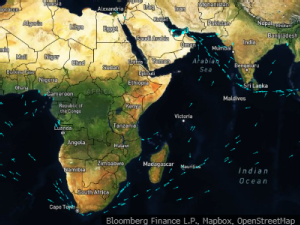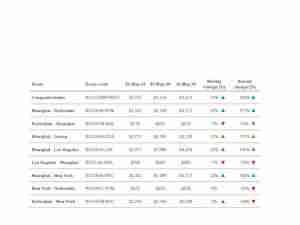A.P. Moller-Maersk A/S, a bellwether for global trade, said a strong start to the year has improved the outlook for container trade demand worldwide.
Global container trade will probably expand 2.5% to 4.5% this year with expectations now landing closer to the upper side of the range, Copenhagen-based Maersk said on Thursday, repeating its forecast range given in February. Maersk is making plans to extend the current rerouting south of the Cape of Good Hope potentially for the rest of the year to avoid the Red Sea, it said.
The world’s supply lines are suffering from a number of disruptions, with the biggest coming from Houthi militant attacks in the Red Sea, which have cut container line transits through the Suez canal by about 80%, according to Bloomberg Intelligence. On top of that, droughts continuing into this year have limited passages through the Panama canal, and the destruction of the Francis Scott Key Bridge has made the Baltimore harbor inaccessible to large vessels.

“We had to redo our network to much more permanently sail south of the Cape” Chief Executive Officer Vincent Clerc said in an interview on Bloomberg TV. “Our view right now is that — as a minimum — we will be well into the second part of the year before we can even consider restarting the network.”
Maersk shares fell as much as 5.6% in Copenhagen, paring the drop to 4% as of 9:36 a.m.
The shares had gained almost 20% in the month through yesterday on hopes higher freight rates would prompt Maersk to increase its forecast, Oystein Vaagen, an analyst at Fearnley Securities, said in a note to clients. While the company raised the lower end of its financial outlook, “we argue the guidance disappoints,” Vaagen said.
Maersk now sees underlying earnings before interest, tax, depreciation and amortization at $4 billion to $6 billion this year, citing strong container market and Red Sea disruptions, compared with its previous forecast of $1 billion to $6 billion.
The extra vessel capacity needed to sail around Africa is boosting freight rates at at a time when the market was entering a post-pandemic slump with ship supply exceeding demand. Maersk still expects overcapacity to prevail which implies lower rates during the second half.
Freight rates “would have to quickly deteriorate in the second half of 2024 should guidance not end up in the higher end or higher,” Vaagen said.
“The possibility that by the end of the year, we will still be sailing south of the Cape, has increased significantly since three months ago,” Clerc said in the interview.









